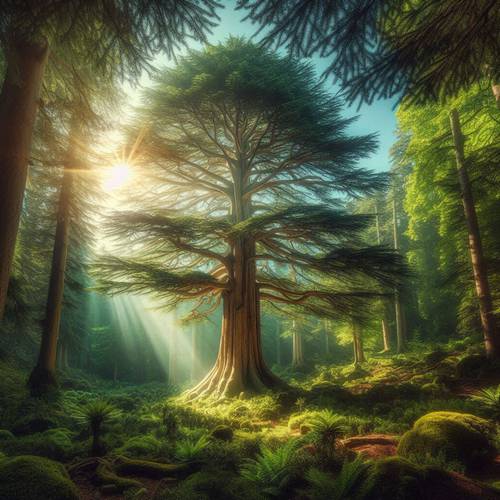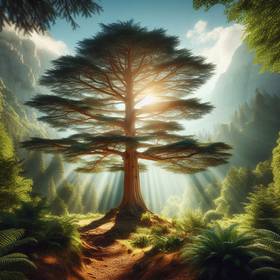True Cedars (Cedrus)
The genus Cedrus, commonly known as cedars, boasts a lineage of majestic trees renowned for their longevity, resilience, and striking beauty. Among the true cedars, four species stand out, each possessing unique characteristics that have captured the imagination of people for centuries:
1. Atlas Cedar (Cedrus atlantica):
This imposing tree, native to the Atlas Mountains of Morocco and Algeria, can reach heights of 100 feet with a spread of 60 feet. The Atlas Cedar's most striking feature is its distinctive blue-green needles, which are often tinged with silver. Its branches, which tend to grow horizontally, create a pyramidal crown that resembles a majestic, ancient sentinel. In landscape design, the Atlas Cedar is prized for its stately presence and ability to thrive in a variety of climates, making it a popular choice for large gardens and parks.
2. Deodar Cedar (Cedrus deodara):
Hailing from the Himalayas of India, Pakistan, and Afghanistan, the Deodar Cedar is characterized by its graceful, weeping habit. Its needles are a soft, silvery-blue, and its branches tend to cascade downwards, creating a cascading waterfall effect. The Deodar Cedar can reach impressive heights of up to 150 feet and its crown often forms a wide-spreading, umbrella-like canopy. This species is renowned for its adaptability and ability to thrive in both temperate and subtropical climates, making it a popular choice for urban landscapes and parks.
3. Cyprus Cedar (Cedrus brevifolia):
This rare and endangered species, endemic to the Troodos Mountains of Cyprus, is a miniature version of its cousins, rarely exceeding 40 feet in height. Its needles are a dark green color, and its branches tend to be more upright than the other species, forming a compact, pyramidal crown. The Cyprus Cedar, although smaller in stature, is no less majestic in its appearance and has been revered for its resilience and adaptation to the harsh conditions of its native habitat.
4. Lebanon Cedar (Cedrus libani):
Perhaps the most iconic of the cedar species, the Lebanon Cedar is native to the Lebanon Mountains, and has been a symbol of strength and endurance for thousands of years. Its imposing stature can reach heights of 120 feet, with a wide-spreading crown of dark green needles. Its branches are strong and horizontal, forming a distinctive flat-topped canopy. The Lebanon Cedar is renowned for its durability and longevity, and its wood has been used for centuries in construction and shipbuilding.
1. Atlas Cedar (Cedrus atlantica):
This imposing tree, native to the Atlas Mountains of Morocco and Algeria, can reach heights of 100 feet with a spread of 60 feet. The Atlas Cedar's most striking feature is its distinctive blue-green needles, which are often tinged with silver. Its branches, which tend to grow horizontally, create a pyramidal crown that resembles a majestic, ancient sentinel. In landscape design, the Atlas Cedar is prized for its stately presence and ability to thrive in a variety of climates, making it a popular choice for large gardens and parks.
2. Deodar Cedar (Cedrus deodara):
Hailing from the Himalayas of India, Pakistan, and Afghanistan, the Deodar Cedar is characterized by its graceful, weeping habit. Its needles are a soft, silvery-blue, and its branches tend to cascade downwards, creating a cascading waterfall effect. The Deodar Cedar can reach impressive heights of up to 150 feet and its crown often forms a wide-spreading, umbrella-like canopy. This species is renowned for its adaptability and ability to thrive in both temperate and subtropical climates, making it a popular choice for urban landscapes and parks.
3. Cyprus Cedar (Cedrus brevifolia):
This rare and endangered species, endemic to the Troodos Mountains of Cyprus, is a miniature version of its cousins, rarely exceeding 40 feet in height. Its needles are a dark green color, and its branches tend to be more upright than the other species, forming a compact, pyramidal crown. The Cyprus Cedar, although smaller in stature, is no less majestic in its appearance and has been revered for its resilience and adaptation to the harsh conditions of its native habitat.
4. Lebanon Cedar (Cedrus libani):
Perhaps the most iconic of the cedar species, the Lebanon Cedar is native to the Lebanon Mountains, and has been a symbol of strength and endurance for thousands of years. Its imposing stature can reach heights of 120 feet, with a wide-spreading crown of dark green needles. Its branches are strong and horizontal, forming a distinctive flat-topped canopy. The Lebanon Cedar is renowned for its durability and longevity, and its wood has been used for centuries in construction and shipbuilding.
False Cedars
While the name "cedar" often conjures images of majestic true cedars like the Lebanon Cedar, a diverse array of other species also bear this title. Let's delve into the world of four notable "false cedars," each captivating in its own right:
1. Western Red Cedar (Thuja plicata):
Towering up to 200 feet tall with a trunk diameter exceeding 10 feet, the Western Red Cedar is a giant of the Pacific Northwest. This evergreen, native to coastal forests from Alaska to California, boasts a distinctive reddish-brown bark that peels in thin strips, revealing a smooth, fibrous underlayer. Its foliage is a rich, dark green, composed of flat, scale-like leaves that release a pleasant, aromatic scent when crushed.
2. Eastern Red Cedar (Juniperus virginiana):
A smaller, more adaptable species, the Eastern Red Cedar thrives across a vast range, from the Atlantic coast to the Great Plains. Reaching heights of 40 to 50 feet, this hardy tree showcases a distinctive bluish-green foliage with a fine, feathery texture. The Eastern Red Cedar produces small, blue-grey berries that are a valuable food source for wildlife. Its fragrant wood, known for its rot resistance, has historically been used for building and crafting.
3. Northern White Cedar (Thuja occidentalis):
Growing up to 60 feet tall with a slender, pyramidal crown, the Northern White Cedar is a graceful tree native to eastern North America. Its distinctive foliage is a soft, bluish-green, composed of delicate, scale-like leaves that release a refreshing, citrusy aroma when crushed. The Northern White Cedar's wood is known for its exceptional durability and resistance to rot, making it a prized material for building canoes, fences, and other outdoor structures.
4. Japanese Cedar (Cryptomeria japonica):
This elegant conifer, native to Japan, can reach heights of 130 feet or more, with a trunk diameter exceeding 10 feet. The Japanese Cedar showcases a distinctive pyramidal crown composed of soft, needle-like leaves that turn a rich, bronze color in the fall. Its bark is a reddish-brown color, peeling in thin strips to reveal a smooth, orange-brown underlayer. The Japanese Cedar is often cultivated as an ornamental tree, prized for its beautiful foliage and graceful form.
1. Western Red Cedar (Thuja plicata):
Towering up to 200 feet tall with a trunk diameter exceeding 10 feet, the Western Red Cedar is a giant of the Pacific Northwest. This evergreen, native to coastal forests from Alaska to California, boasts a distinctive reddish-brown bark that peels in thin strips, revealing a smooth, fibrous underlayer. Its foliage is a rich, dark green, composed of flat, scale-like leaves that release a pleasant, aromatic scent when crushed.
2. Eastern Red Cedar (Juniperus virginiana):
A smaller, more adaptable species, the Eastern Red Cedar thrives across a vast range, from the Atlantic coast to the Great Plains. Reaching heights of 40 to 50 feet, this hardy tree showcases a distinctive bluish-green foliage with a fine, feathery texture. The Eastern Red Cedar produces small, blue-grey berries that are a valuable food source for wildlife. Its fragrant wood, known for its rot resistance, has historically been used for building and crafting.
3. Northern White Cedar (Thuja occidentalis):
Growing up to 60 feet tall with a slender, pyramidal crown, the Northern White Cedar is a graceful tree native to eastern North America. Its distinctive foliage is a soft, bluish-green, composed of delicate, scale-like leaves that release a refreshing, citrusy aroma when crushed. The Northern White Cedar's wood is known for its exceptional durability and resistance to rot, making it a prized material for building canoes, fences, and other outdoor structures.
4. Japanese Cedar (Cryptomeria japonica):
This elegant conifer, native to Japan, can reach heights of 130 feet or more, with a trunk diameter exceeding 10 feet. The Japanese Cedar showcases a distinctive pyramidal crown composed of soft, needle-like leaves that turn a rich, bronze color in the fall. Its bark is a reddish-brown color, peeling in thin strips to reveal a smooth, orange-brown underlayer. The Japanese Cedar is often cultivated as an ornamental tree, prized for its beautiful foliage and graceful form.



